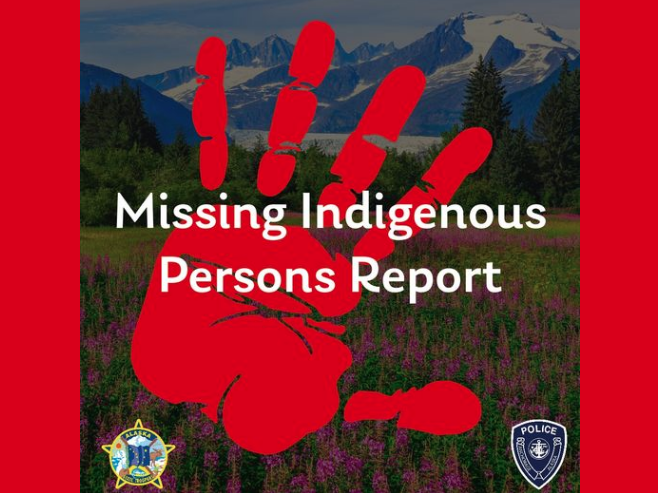
- Details
- By Elyse Wild
The Alaska Department of Public Safety (DPS) and Anchorage Police Department (APD) have released the state’s first quarterly Missing Indigenous Persons Report.
The 13-page report includes information on people who are Alaska Native, American Indian or of an unknown race who were reported missing in Alaska as of July 14, 2023, and whose cases are being investigated by the DPS and APD.
Along with race, sex, and date of last contact, cases in the report are categorized by circumstance, including “suspicious,” “not suspicious,” “environmental,” or “unknown.” According to a statement from the DPS, each case was reviewed by DPS and ADP to determine the circumstance.
The report shows that from April 1, 2023, to June 30, 2023, 199 people who are Alaska Native, American Indian, or of unknown race were reported missing, with 174 located during that same time period.
“We hope that with DPS and APD having information at their fingertips, that we see it translate into meaningful action,” Charlene Apok, Executive Director of Data for Indigenous Justice, told Alaska’s News Source.
The report, according to the DPS, is a result of the state’s People First Initiative, a working group launched in 2021 to focus on five policy areas that affect Alaskans, including the MMIP crisis.Earlier this year, DPS added additional data points to the Alaska Missing Persons Clearinghouse, a public database meant to track all missing persons cases reported in Alaska. The new data points include the race and sex of every person listed in the Clearinghouse, which allows for users to see how many Alaska Natives are missing statewide.
According to data from the Centers for Disease Control and Prevention, Native women living on reservations are murdered at a rate ten times higher than the national average. Layered jurisdiction, lack of collaboration between law enforcement bodies, and systemic apathy have led to thousands of unsolved cases in Indian Country. The Bureau of Indian Affairs estimates there are 4,200 unsolved MMIP cases.
According to the Urban Indian Health Institute, Alaska is among the ten states with the highest number of missing and murdered Indigenous people.
More Stories Like This
Native News Weekly (August 25, 2024): D.C. BriefsUS Presidents in Their Own Words Concerning American Indians
Indigenous Actor Elaine Miles Reports Detention by Alleged ICE Agents
Happy Thanksgiving from Native News Online
Coming Up on Native Bidaské: Behind the Animation: Joey Clift Talks “Pow” and Native Storytelling
Help us tell the stories that could save Native languages and food traditions
At a critical moment for Indian Country, Native News Online is embarking on our most ambitious reporting project yet: "Cultivating Culture," a three-year investigation into two forces shaping Native community survival—food sovereignty and language revitalization.
The devastating impact of COVID-19 accelerated the loss of Native elders and with them, irreplaceable cultural knowledge. Yet across tribal communities, innovative leaders are fighting back, reclaiming traditional food systems and breathing new life into Native languages. These aren't just cultural preservation efforts—they're powerful pathways to community health, healing, and resilience.
Our dedicated reporting team will spend three years documenting these stories through on-the-ground reporting in 18 tribal communities, producing over 200 in-depth stories, 18 podcast episodes, and multimedia content that amplifies Indigenous voices. We'll show policymakers, funders, and allies how cultural restoration directly impacts physical and mental wellness while celebrating successful models of sovereignty and self-determination.
This isn't corporate media parachuting into Indian Country for a quick story. This is sustained, relationship-based journalism by Native reporters who understand these communities. It's "Warrior Journalism"—fearless reporting that serves the 5.5 million readers who depend on us for news that mainstream media often ignores.
We need your help right now. While we've secured partial funding, we're still $450,000 short of our three-year budget. Our immediate goal is $25,000 this month to keep this critical work moving forward—funding reporter salaries, travel to remote communities, photography, and the deep reporting these stories deserve.
Every dollar directly supports Indigenous journalists telling Indigenous stories. Whether it's $5 or $50, your contribution ensures these vital narratives of resilience, innovation, and hope don't disappear into silence.
 The stakes couldn't be higher. Native languages are being lost at an alarming rate. Food insecurity plagues many tribal communities. But solutions are emerging, and these stories need to be told.
The stakes couldn't be higher. Native languages are being lost at an alarming rate. Food insecurity plagues many tribal communities. But solutions are emerging, and these stories need to be told.
Support independent Native journalism. Fund the stories that matter.
Levi Rickert (Potawatomi), Editor & Publisher

